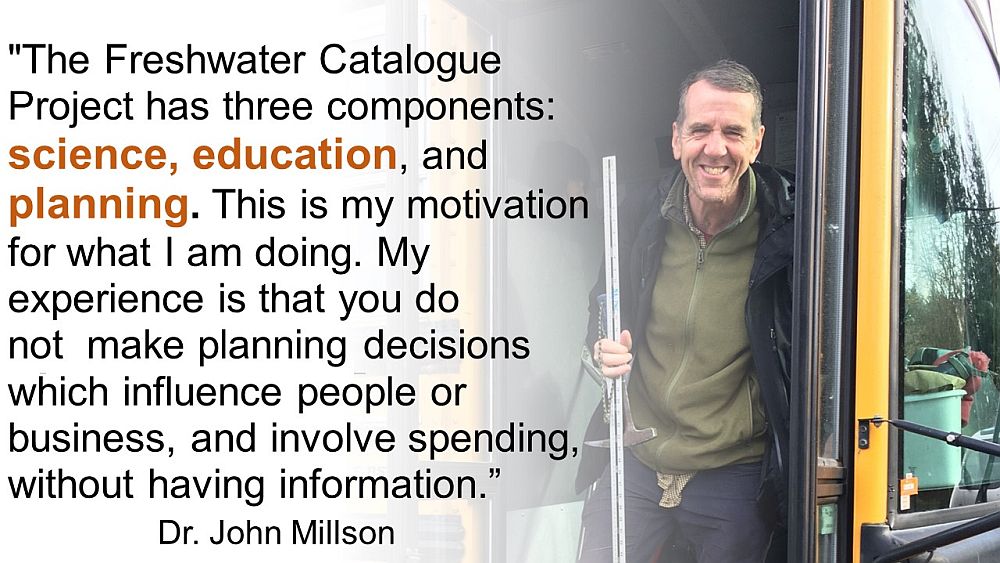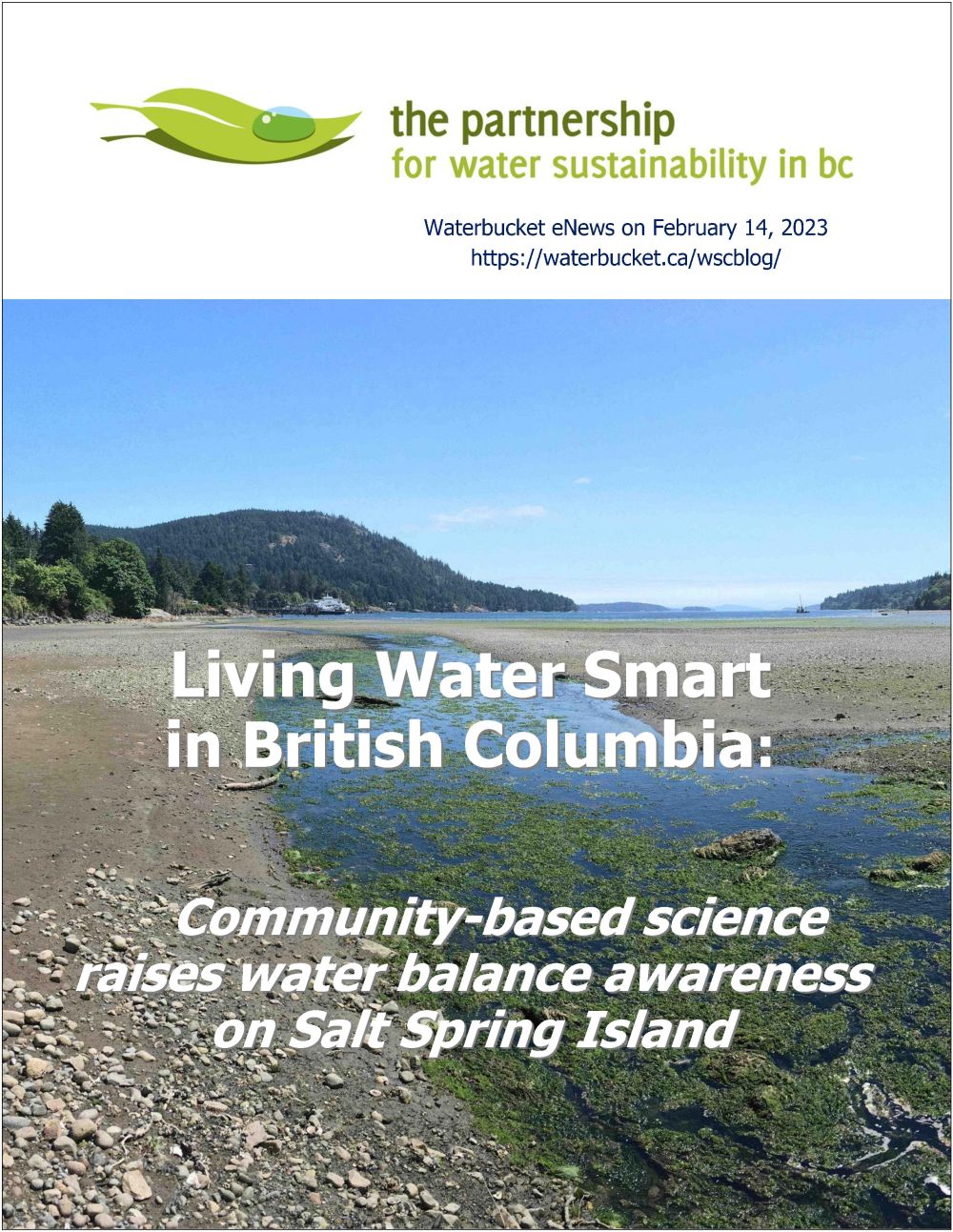Community-based science raises water balance awareness on Salt Spring Island

Note to Reader:
Waterbucket eNews celebrates the leadership of individuals and organizations who are guided by the Living Water Smart vision. Storylines accommodate a range of reader attention spans. Read the headline and move on, or take the time to delve deeper – it is your choice! Downloadable versions are available at Living Water Smart in British Columbia: The Series.
The edition published on on February 14, 2023 the Salt Spring Island Water Preservation Society’s FreshWater Catalogue. They are applying a science-based approach to help educate the community about the fragile nature of the “water balance” on Salt Spring.

“Community-based science should be used to inform science models and planning. The Salt Spring Island Water Preservation Society is making a successful step in that direction,” states Dr. John Millson
With the launch of the Watershed Moments Symposia Series in 2018, a key theme for “stories behind the stories” published on Waterbucket eNews is this: local government partnerships with stewardship groups can be transformational and ‘make where we live better’. This is the context for the story below about citizen science in action on Salt Spring Island.
Inspired by the leadership of Dr. John Millson, the Salt Spring Island Water Preservation Society’s FreshWater Catalogue has in recent years mobilized a small army of volunteers. A retired geologist, John is passionate about using science and Indigenous knowledge to show the way forward to protect the freshwater and watersheds of Salt Spring’s drinking-water systems.
The Freshwater Catalogue project is applying a science-based approach to help educate the community about the fragile nature of the “water balance” on Salt Spring. As John explains it, “Doing science and making learnings from science accessible to a community is key to having them onboard.”
Shaped By Water: The Film
In support of accessible educational material based on the science, the Salt Spring Island Water Preservation Society has a vision which is to produce a film documentary, with a working title Shaped By Water: The Story of Salt Spring Island’s Freshwater Journey. It is the sequel to Freshwater Salt Spring, a short pilot film. To view it, click on the image below.
As a communication and educational tool, the feature film would support the messaging about an Island’s delicate freshwater balance, and the importance of its watersheds and their natural systems in maintaining this balance, for the natural ecosystems and for the community.
EDITOR’S PERSPECTIVE / CONTEXT FOR BUSY READER
“My conversational interview with John Millson was fascinating. He is so enthusiastic about what he is doing in his “post-career”. The freshwater project is a full-time job that comes with no financial compensation but infinite satisfaction from making a difference in bringing threads of understanding from the past through to the present and beyond,” stated Kim Stephens, Waterbucket eNews Editor and Partnership Executive Director.
“It resonated with me that John Millson brings that magical combination of knowledge, wisdom and passion to his post-career mission. My takeaway from our conversation is that his vision for the Shaped By Water film initiative aligns perfectly with what Michael Blackstock teaches us about Blue Ecology.”
“Blue Ecology is a water-first approach to interweaving Indigenous and Western perspectives. Oral history, land and water stewardship, and the inter-generational baton. These are foundational pieces for water reconciliation.”
“John Millson used the Indigenous phrase “seeing with two eyes” when he shared an example of what interweaving means to him. He described the experience as uplifting when he met with local First Nations in the field: I am the scientist. They have the oral history and knowledge from those thousands of years that they have been on Salt Spring. They give us a real sense of place.”
John Millson – an overview of his mission
“Salt Spring island freshwater science is developing a-pace, with field based (citizen) science contributing to office based (agency) studies reported, ongoing, or in planning. An understanding of our island’s freshwater systems is becoming available now, raising awareness of what is ‘a delicate freshwater balance’. Leveraging this developing understanding, in all things community-oriented, is a key step in gaining broader engagement and support.”
A video extract from our conversation:
To help readers understand why I enjoyed interviewing John Millson, we have incorporated a 63-second clip of John explaining why he got involved. Click on the image.
https://www.youtube.com/watch?v=sIGNdU_4Nb0
STORY BEHIND THE STORY: Community-based science raises freshwater awareness on Salt Spring Island – conversational interview with John Millson
“I am a geologist, and it has been my passion since age 8. And geology links quite naturally into an understanding of water resources. And so, when I retired to Salt Spring Island, I became heavily involved in some of the (community-based) science work that is underway on the island,” explains John Millson.
Science informs planning through education
“The Salt Spring Island Water Preservation Society, Freshwater Catalogue Project that I am leading is providing field data for ground-truthing, as I call it, for some of the community-based science work that we are doing to support the work by the Islands Trust and Capital Regional District. The project has been running for 5 years. We have collected over 7000 data points.”
“The data can help us understand water quantity variability and water balance for an island. It all hangs together and dovetails nicely in a multi-threaded, decision-making process. Water quantity is such a big deal. Why is that? Well, islands only have rainwater for water supply. So, that is the backdrop.”
“The project has three components: science, education, and planning. This is my motivation for what I am doing. One, let’s develop the science, two, share that with the public. That reaches into the education side of it, and three, the information needs to be used to inform planning! My experience is that you do not make planning decisions which influence people or business, and involve spending, without having sufficient information.”
“We can do some fantastic science work, we can even achieve some ‘accuracy’ with our numbers, and we can say this is what we are going to base our planning decisions on. Unfortunately, if the public is not on board because they do not understand it, you are screwed. Lay people are not scientists. So, the last thing we want to do is overwhelm them with science. Developing accessible educational material is key.”

In the photo above, John Millson is retrieving FreshWater Catalogue creek field data from an in-field datalogger
Mobilize a community through science in action, on the ground
“What are the SIMPLE takeaways that will bring the public on board, so that they see the value of doing the science and perhaps even get involved in a stewardship project? My hope is that one day, and perhaps for many years down the road, we might have a SSI-wide Drinking Water & Watershed Protection group, with community buy-in and involvement.”
“The education side has been enlightening because of our community field and event engagements and having had some 40 to 50 volunteers working with me on different aspects of the project – including field data collection, data management, data analysis, and development of tools for data capture, visualisation and analysis.”
“Levering volunteer and community interactions, has given clear pointers to where community knowledge gaps are. Working (with others) on filling these gaps is an ongoing process, and has been a rich, and rewarding experience.”
Towards Water Balance
“At the same time, the project has led me to have conversations with over 300 people on the island. I come away from those conversations with impressions of what they want to know and what don’t they know. With that as our starting point, we can work on a balanced education program. Already I am doing educational programs with schools and starting collaboration with local First Nations.”
“It has also given me some very clear pointers as to where the gaps are. A fundamental observation with many people is that they have no idea about the water balance and how groundwater connects to surface water. Nor do they understand why it is important that surface water be managed to protect groundwater and why the natural systems are important to capture the surface water. And so we are working on that education piece.”
“Education is a slow process when working through the school system. The schools themselves are so busy with so much else that is going on. It is a challenge, first to make the connections; and secondly for them to actually have class and field time. We need another way-in, and for getting information out, with the kids becoming ambassadors. And that is THE FILM PROJECT.”

The photo above is of a developing young ambassadors school FreshWater Catalogue field learning event
Shaped By Water: The Film
“The Freshwater Salt Spring film-short that we made previously was a pilot. We had a kind donation and put the money to good use. We involved kids and incorporated key Indigenous contributions. The video is a freshwater on an island educational entry point to a larger group on the island, and it was a proof of concept.”
“But the bigger plan is to make another documentary or docu-series. This, Shaped By Water, is more than just a concept. We are working to put the idea in play. It will be a collaborative stewardship project with First Nations involvement. They give us a valuable sense of place and the need to be stewards of land and water. Other stewardship groups are also our key partners in any island’s freshwater stewardship story.””The introduction to a Shaped By Water film will be, we are the filmmakers, who are we. Then we will get into our freshwater on an island. What is it? Where does it come from? And the unfolding science? We are looking for illustrators and an animator to help pitch our educational messaging.”
“The film’s entry point is, this island is shaped by ice and guess what, WATER! We have the storyboard mapped out, and some partners in-place. We just need funding to bring together a film-team and make it happen.”
“The takeaway message for this story is that COMMUNITY-BASED SCIENCE can be used to inform science models and planning. The Salt Spring Island Water Preservation Society has made a successful step in that direction. We were a part of a CRD (and Island Trust) study of the Salt Spring Island Weston Lake Watershed which is all about water availability for this part of the island. That is a good news story,” concludes John Millson.


To learn more about the Water Balance Equation, download a copy of Living Water Smart: Adapting Asset Management to Climate Realities.
Did you enjoy this article? Would you like a PDF document version? Click on the image below to download your copy.

About the Partnership for Water Sustainability in BC
Technical knowledge alone is not enough to resolve water challenges facing BC. Making things happen in the real world requires an appreciation and understanding of human behaviour, combined with a knowledge of how decisions are made. It takes a career to figure this out.
The Partnership has a primary goal, to build bridges of understanding and pass the baton from the past to the present and future. To achieve the goal, the Partnership is growing a network in the local government setting. This network embraces collaborative leadership and inter-generational collaboration.
TO LEARN MORE, VISIT: https://waterbucket.ca/about-us/

